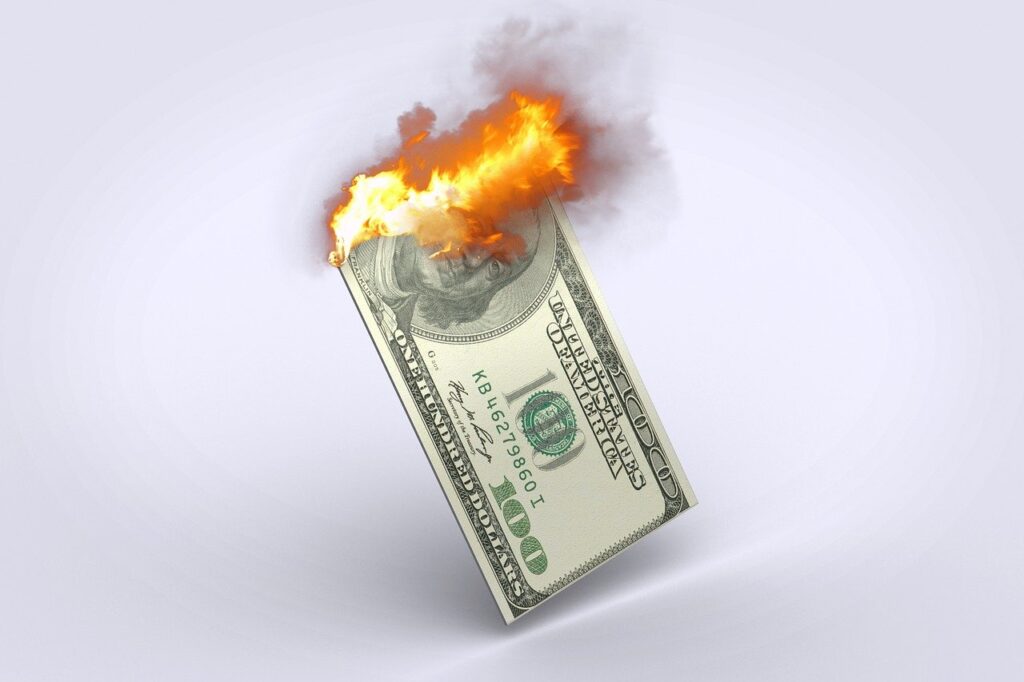[ad_1]
The new COVID variant, Omicron (B.1.529) was first detected in South Africa in November 2021. Omicron is quickly becoming the dominant COVID variant. i
Preliminary reports are showing Omicron is less potent, which is leading to less hospitalizations per infected cases. Reported symptoms seem to be more mild as the variant doesn’t seem to attack the respiratory system as hard. However, it also seems as if Omicron is more contagious than previous variants.
Given we went through the Delta variant without too many hiccups, the investment thesis for this latest variant should hopefully be similar. Let’s review this latest COVID variant investment thesis for stocks and real estate.
Overall COVID Variant Investment Thesis: Buy The Dip
Thanks to our experience since 1Q2020 dealing with earlier variants, we now have a decent roadmap for what to expect. Therefore, if there is another sustained surge, we can expect less safety compliance, less fear, and more economic activity.
In other words, things won’t get as bad this time around. Therefore, we can rule out another 32% S&P 500 correction like the one we saw in March 2020. Therefore, I’m nibbling on the selloff. COVID will be endemic. We just have to learn to live with it.
However, we could easily see a 10% – 15% S&P 500 correction that would bring the index back down to the 4,000 – 4,100 range. Valuations are expensive and corporations must grow earnings to meet high expectations.
As for real estate, the new variant should be good for real estate as more people spend more time at home again. Interest rates will likely decline as Treasury bonds get bid up. Further, more people will try and convert more paper money profits into hard assets.
Let’s get into more detail.
New COVID Variant Investment Thesis: Stocks
Since none of us have future-revealing crystal balls, we must accept our COVID variant investment thesis could be dead wrong. However, if we logically think things through, hopefully, we’ll have a greater than a 50% chance our investment thesis will be right.
When it comes to building wealth, our net worth allocation is the biggest determining factor. However, when it comes to active investing, all we need is enough 51% chances to outperform.
Again, expect the S&P 500 to decline by 10% – 15% if the new Omicron variant rages as much as the alpha variant. After the correction, we can assume new booster shots will target the B.1.1.529 variant and things will more quickly get back to normal.
Therefore, if there is a 10%+ correction in the S&P 500 (4,150 – 4,200), I would be aggressively buying the dip. I expect the S&P 500 to recover all its losses within three months of the correction and the market to reach new highs.
Outperformers In A New COVID Variant Scenario
During the worst of the Omicron variant spread, these sectors/stocks may perform the best.
- Home media: Netflix, Disney, Hulu, Roku
- Food delivery: DoorDash, Postmates, HelloFresh
- Home furnishing/remodeling: Wayfair, Home Depot
- Home fitness: Peloton
- REITs, eREITs, real estate ETFs: Vanguard Real Estate, American Homes 4 Rent, Realty Income
- Social media: Twitter, Snapchat, Facebook
- Big tech: Apple, Google, Amazon, Microsoft
- Pharma: Pfizer, Moderna
Underperformers In A New COVID Variant Surge
During the worst of the new COVID variant spread, these sectors/stocks will likely underperform the S&P 500. If there is a omicron variant booster shot or if the variant starts to get under control, there’s a greater chance these sectors/stocks will then begin to outperform.
- Financial (XLF): JP Morgan, Chase, Wells Fargo
- Materials (XLB): Newmont Corp, Dow Inc, Linde PLC
- Industrials (XLI): Honeywell, UPS, Union Pacific, Boeing
- Cruises & Airlines: Delta Airlines, Norwegian Cruise Lines, Carnival Corp
- Small-Cap Russell 2000: Plug Power, Novanax, Penn National Gaming, Caesars Entertainment
New Omicron COVID Variant Investment Thesis: Real Estate
The new COVID variant makes me bullish on real estate due to a decline in interest rates, an increased desire to own hard assets, and more time spent at home. Whenever you spend more time using something, its intrinsic value goes up.
One of the reasons why I’ve been seeing more online search traffic tick up about migrating to California and Hawaii is due to higher vaccination rates. The combination of a better lifestyle, more job opportunities, better weather, and higher vaccination rates is alluring to some people.
Therefore, if the omicron variant becomes a beast, there will at least likely be a slowdown of people migrating to the Midwest and South to save money.
Below is a map of risk levels by state by Johns Hopkins University back in August 11, 2021, when the Delta variant was spreading rapidly. Today, the COVID risk levels are relatively similar by state.

Underperforming States During A New COVID Variant Surge
- Arkansas
- Louisiana
- Florida
- Mississippi
- Alabama
- Kansas
- Oklahoma
- Wyoming
- Nevada
- Utah
- Arizona
Most of these states either have lower vaccination rates, more liberal mask and social distancing mandates, unhealthier people, or a combination of all items.
Therefore, at the margin, these states may be relative underperformers from a real estate investment standpoint as investors avoid these states until things get better. If enough hospitalizations and deaths occur, economic activity will slow down.
On the flip side, more individual liberties may result in more economic activity, which could boost real estate prices further. I’m hypothesizing that enough people have died from the coronavirus that people in the most affected states will take things more seriously this time around.
Unfortunately, I don’t see the southeastern states like Mississippi, Alabama, and Arkansas climbing out of the bottom 10% poorest states in the country any time soon. It takes time to change.

Outperforming States During A New COVID Variant Surge
Given all of us have already gone through 1.8+ years of a pandemic, at the margin, we should be more comfortable living with this disease. Therefore, I don’t see as many people fleeing big cities like San Francisco, New York, and Boston as much this time around. Safety protocols are robust in these cities.
The midwestern and southern states have had their time to outperform during previous variants. As a result, I see a normalization of real estate price increases where the fastest growing cities slow down and the slowest growing cities stay the same or increase.
Check out this Burns Home Value Index chart highlighting May price increases and upcoming supply. If you read my heartland real estate investment thesis piece from 2016 and took action, you are now well in the money owning Austin, Dallas, and San Antonio property.

It is highly unlikely cities like Austin will see a similar level of price growth under another COVID variant scenario. House price growth cannot outstrip income growth by that much for too long. Further, be aware of rising supply in cities with the highest price appreciation.
Instead, I expect to see the above graph look more uniform around the overall United States real estate price growth figure. In other words, big cities will underperform less. Price growth for 18-hour cities will slow.
Big Cities Should Underperform Less
Due to high cost, I don’t think real estate prices in cities like New York and San Francisco will outperform 18-hour cities like Charlotte or Charleston for a while. The “spreading out of America” is a permanent trend. The law of large numbers is also hard to overcome.
However, don’t feel sorry for residents in higher-cost cities. Even a 10% price increase on a $2 million home is equivalent to a 40% increase on a $500,000 home. The main difference may be that big city residents also have higher incomes and a larger public investment portfolios.
If larger public investment portfolios so happen to be concentrated in sectors that outperform, then the wealth gains can be enormous. I know plenty of people who became millionaires and multi-millionaires in the San Francisco Bay Area after the NASDAQ closed up 43% in 2020.
One guy I know joined a San Francisco startup two years ago when it was valued at $500 million. Recently, the company raised a large round that valued the company at $10 billion! He is now a deca-millionaire on paper.
Although big city real estate will underperform less, they will likely still underperform. Therefore, it’s up to you to take in all the variables of lifestyle, income, family, and friends to decide where you want to live.
Personally, I’ve used part of my Buy Utility, Rent Luxury (BURL) strategy to invest. In other words, I have continued to live in an expensive city like San Francisco for lifestyle reasons and invest in less expensive cities like Charleston for capital gains reasons.
My Invest Strategy If Things Get Worse
If the latest COVID variant aggressively spreads, bonds will do well and yields will decline. We already see the 10-year bond yield below 1.4%. Therefore, I’m happy to keep my existing bond positions and will focus on putting new money to work in real estate.
In my post, Why The Housing Market Won’t Crash Any Time Soon, one of the bullish housing scenarios I discussed was a bear market in stocks resulting in a bull market in bonds and a decline in rates.
We saw this mini-scenario play out on July 19 when the S&P 500 declined by 1.2% and bond yields declined to 1.18% from 1.3%. We saw this scenario play out for years after the 2000 dotcom bust.
If the new COVID variant doesn’t ravage the economy, then strong economic growth will do well for stocks and real estate. Bonds may underperform. However, bonds have done incredibly well in a multi-decade stock bull market. Therefore, don’t completely disregard bonds just because interest rates are low.
I’m investing in a build-to-rent fund because I believe rents will continue to go up. I don’t currently have enough capital to buy another physical rental property, nor am I sure I want to given time constraints as a father.
My current real estate exposure consists of three rental properties in San Francisco, a rental property in Lake Tahoe, multiple real estate crowdfunding investments, and various real estate public securities. These investments make up roughly 40% of my net worth.
Watching Stock Underperformers
On the stock side, my focus is on the sectors and names in the Underperformers category. The reason why is because I’m already long names in the Outperformers category (tech, media).
JETS, RCL, CCL, and XLB are the main securities on my watch list. Airlines and cruise ships have up to ~30% downside from current levels if the new COVID variant shuts us down. If these stocks do decline by this magnitude, eventually I believe they will recover by 50%+. I also bought health and fitness stocks as a laggard reopening trade.
It’s important to develop a watch list because, otherwise, you’ll tend to buy what you’ve always been buying. A great investor is always prepared and trying to connect the dots.
Given I believe there will be booster shots to counteract new variants, I expect the Underperformers to eventually outperform again. In other words, I’m looking for a mean reversion.
Boosting Cash As Well
Finally, I am happily stacking cash in order to take advantage of a potential 10-15% correction in the S&P 500. I only assign a 25% chance there will be a correction of this magnitude. However, I still want to have a decent amount of cash to deploy if it does.
Having a robust investment portfolio and a large cash hoard feels good after a massive rally. I’m currently deploying capital into a venture debt fund, which has a lower risk profile than venture capital funds I’m also investing in.
Let’s hope things don’t get too bad with the new COVID variant But if they do, now we’ve got a plan.
Diversify Your Investments Into Real Estate
Stocks are very volatile compared to real estate. Therefore, if you want to dampen volatility and build wealth at the same time, invest in real estate. Real estate is my favorite asset class to build wealth.
The combination of rising rents and rising capital values is a very powerful wealth-builder. By the time I was 30, I had bought two properties in San Francisco and one property in Lake Tahoe. These properties now generate a significant amount of mostly passive income.
In 2016, I started diversifying into heartland real estate to take advantage of lower valuations and higher cap rates. I did so by investing $810,000 with real estate crowdfunding platforms. With interest rates down, the value of cash flow is up. Further, the pandemic has made working from home more common.
Check out my favorite platform, Fundrise. Fundrise enables investors to diversify into real estate through private eREITs. Fundrise has been around since 2012 and has consistently generated steady returns, no matter what the stock market is doing.
For most people, investing in a diversified eREIT is the easiest way to gain real estate exposure.
Related posts:
Recommended Split Between Active And Passive Investing
How I’d Invest $100,000 Today For More Greater Returns And Some Joy
To Get Rich, You Must Practice Predicting The Future
Readers, what is your new COVID variant investment thesis? What are you waiting to buy if things start getting very bad again? Are you putting more capital to work in real estate or stocks? Or are you buying something else or hoarding cash?
Disclaimer: I’ve written my investment thesis and what I plan to do with my money. Given you are not me, please write your own investment thesis and follow your own objectives. Invest at your own risk.
For more nuanced personal finance content, sign up for my free newsletter. Financial Samurai started in 2009 and is one of the top independently-run personal finance sites today.
[ad_2]



